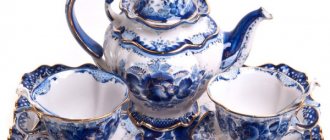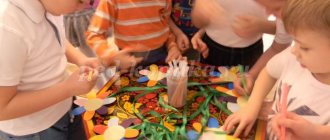Summary of a lesson in the preparatory group of a preschool educational institution. Checkers game
Teaching preschoolers to play checkers
Goal : To teach children to play checkers. Objectives: To consolidate children's knowledge about the game of checkers, to consolidate the rules of the game, the ability to use numbers as a result of measurement, to determine the equality of several groups of objects by number. Enrich children's vocabulary with new words: checkers player, tournament, partner, diagonal, draw. Develop an interest in the game of checkers, the ability to be friendly and respectful towards each other, the desire to strive for success, and cultivate a sense of self-confidence. Material: Checkers.
Progress of activities:
— I want to inform you that this month in our city there will be a checkers tournament among children who go to kindergartens.
Would you like to take part? Then I suggest you start preparing for this tournament, remember everything we know about the game of checkers and consolidate the rules of the game. I. — Guys, how many of you know what a tournament is? (type of competition) - What is the name of the person who plays checkers? (Checks player) - What should a checkers player be like? (Well-mannered, self-possessed, kind, etc.) - What do you need to play checkers? (Partner, checkerboard, checkers, knowledge of the rules of the game) Children set up an algorithm. - Who can play checkers? (Any person) - Who can be a partner for the game? (Any person) - How do partners greet each other at the beginning and end of the game? (Shake hands at the beginning and end of the game) II. — Guys, the checkers board is very unusual and is fraught with a lot of mysterious mysteries. Let's try together to unravel and declassify all the strange secrets of the magic board. The children sit at the tables. - I will ask you questions, and you try to answer them accurately, carefully peering at the checkers board, slowly studying it. - What do you see on the board? (Identical small squares that alternate in color) - How are they similar and how are they different? (Similar in shape and size, but different in color) - “All in squares - white, black, checkerboard...” Count how many white and black squares there are in total? Boys count white squares, and girls count black squares. (White cells 32, black cells 32) - What can be said about the number of black and white cells? (The same number, equally, 32 each, as many as white, as many as black) - I want to tell you that the cells can be white and brown, white and green, white and red, but they are always called white and black. What is the name of each of the squares or cells? (Field) - Check if you have positioned your boards correctly? Remember that the corner box on the right is always white, and the corner box on the left is always black. - Do you know that the checkers board consists not only of square fields, but also of many different paths, paths, and they have different names. What are the names of straight lines that go from left to right and right to left? (Horizontal lines) - Count how many there are on the board? (8 horizontal lines) - Now label each line with a number. The number is placed on the side to the left and right of the board. But we will only put it on the left. (performed with children) - What are the lines that go from top to bottom and bottom to top called? (Vertical lines) - Yes, and they are designated by numbers of the Latin alphabet. I suggest you draw one horizontal line with a blue pencil and one vertical line with a red pencil, and compare them in length. —Which line is longer: horizontal or vertical? (Lines are equal) - I suggest you play. To do this you need to split into two teams. (Children take the numbers and divide them into even and odd) - The evil wizard scattered the checkerboards horizontally. We need to collect them, let's try! (Children do the task at the round table) - Well done! You have defeated the evil wizard's cunning! But there are also lines on the checkerboard, they go diagonally - diagonal lines are certainly the same color. Our checkers will move only along black diagonal lines. Let's compare them by length. (Diagonal lines are different in length) - We have found out that horizontal lines are indicated by numbers, vertical lines by letters, these are the main lines. How are diagonal ones designated? Guys, diagonal lines are obtained from the intersection of vertical and horizontal lines, and are indicated by a letter and a number. For example, A1, L8. — What else do you think is denoted by a letter and a number? (Cells - fields) - Yes, each of the 64 fields has its own address, its own unique name. In checkers, it is customary to name the letter first and then the number. Game “Find the Field” The teacher gives the children 2 chips with the address of the fields, and the children must find and place their chip in the correct field. - So you got acquainted with the magic board and the place where checkers battles will be played. Physical exercise. “And now I suggest you relax a little and play a game with magic palms.” Be very careful! The teacher shows palms made of cardboard of different colors one by one, purple - the children freeze, yellow - they whisper, red - they scream. III. — We have learned the secrets of the checkers board, but what else do we need to talk about? (about checkers) Children sit at a round table. — On which squares are the checkers located? (On black) - How many checkers is given to each player? (12 checkers each) - How are the checkers located at the beginning of the game? (On three horizontal lines on each side) “White detachment, black detachment, Two troops stand opposite each other. Strict order in one squad, Exactly the same in another squad” - Which checkers by color start the first move? (white checkers) - How to determine who should play which? (Using lots, in amateur games, they simply hold 1 checker of a different color in both hands, and invite the partner to choose one of the two. Which checker he chooses, he should play with that color) IV .- Any game, be it checkers or football, tennis or hockey, has its own rules of the game. Remember and name the rules that you know, and we will place them on the board. Rules of the game • Touched - go. • With a “quiet move, the checker moves only forward” • The king can move in any direction and to any distance. • If the checker reaches the last horizontal line, it turns into a king. • If there are several opponent's checkers in the path of the hitting checker, you need to hit them all. • The impact stroke can be made both forward and backward. • Capturing the opponent's checker is mandatory . Gentleman's rules. • You should not give hints or distract your opponent’s attention. • Don't laugh at someone else's loss. • Remove checkers carefully, without unnecessary noise. Conclusion: when playing checkers you need to behave like a well-mannered and cultured person. — Guys, when is the game considered finished? • if the opponent does not have a single chip left; • if the opponent has chips, but cannot make a move, this happens when the checkers freeze; • if the opponent admits himself defeated; • in the event that there is a draw (this is the end of the game when no one is awarded a victory) V .: Remember that a loss cannot be considered something shameful. V. - Guys, you are great! We went through the ABCs of the game of checkers and established the rules of the game.
We recommend watching:
Abstract of the GCD on the topic: Winter for children of the preparatory group. Summary of a lesson on speech development for children of the preparatory group. Early spring Summary of GCD in the preparatory group on the topic: Circus. Speech development Scenario for a checkers tournament in kindergarten for older preschoolers
Similar articles:
Summary of the lesson “Take care of nature” in the preparatory group
Lesson summary on the topic: “The miracle game of checkers” (1st grade)
Topic of the lesson: “The miracle game - checkers”
Target:
Teach children to play checkers.
Tasks:
Correctional, developmental and educational tasks:
- To consolidate children's knowledge about the game of checkers, to consolidate the rules of the game,
- the ability to use number as a result of measurement, determine the equality of several groups of objects by number (the same number, 32, 12, the same number, equally, the concepts of even and odd numbers.
- Exercise in the ability to navigate on a plane, consolidate concepts: vertical, horizontal lines, introduce the diagonal line, in the ability to create an activity algorithm.
- Enrich children's vocabulary with new words: checkers player, tournament, partner, diagonal, draw.
Educational task
:
Develop an interest in the game of checkers, the ability to be friendly and respectful towards each other, the desire to strive for success, and cultivate a sense of self-confidence.
Equipment
: chessboard, set of checkers.
Progress of activities:
— I want to inform you that this month a checkers tournament among children will be held in our city. Would you like to take part?
Then I suggest you start preparing for this tournament, remember everything we know about the game of checkers and consolidate the rules of the game.
I.
— Guys, how many of you know what a tournament is? (type of competition)
— What is the name of the person who plays checkers? (Checkers player)
- What should a checkers player be like? (Well-mannered, seasoned, kind, etc.)
— What do you need to play checkers? (Partner, checkers board, checkers, knowledge of the rules of the game)
Children present an algorithm.
- Who can play checkers? (Anyone)
— Who can be a partner for the game? (Anyone)
— How do partners greet each other at the beginning and end of the game? (Shake hands at the beginning and end of the game)
II.
— Guys, the checkers board is very unusual and is fraught with a lot of mysterious mysteries. Let's try together to unravel and declassify all the strange secrets of the magic board.
The children sit at the tables.
- I will ask you questions, and you try to answer them accurately, carefully peering at the checkers board, slowly studying it.
- What do you see on the board? (Identical small squares that alternate in color)
- How are they similar and how are they different? (Similar in shape and size, but different in color)
- “All in squares - white, black, checkerboard ...”
Count how many white and black cells there are? Boys count white squares, and girls count black squares. (White cells 32, black cells 32)
- What can be said about the number of black and white cells? (The same number, equally, 32 each, as many whites as there are blacks)
- I want to tell you that cells can be white and brown, white and green, white and red, but they are always called white and black.
What is the name of each of the squares or cells? (Field)
— Check, have you positioned your boards correctly?
Remember that the corner box on the right is always white, and the corner box on the left is always black.
- Do you know that the checkers board consists not only of square fields, but also of many different paths, paths, and they have different names.
What are the names of straight lines that go from left to right and right to left? (Horizontal lines)
- Count how many there are on the board? (8 horizontal lines)
- Now label each line with a number. The number is placed on the side to the left and right of the board. But we will only put it on the left. (Performance with children)
- What are the lines that go from top to bottom and bottom to top called? (Vertical lines)
— Yes, and they are designated by numbers of the Latin alphabet. I suggest you draw one horizontal line with a blue pencil and one vertical line with a red pencil, and compare them in length.
—Which line is longer: horizontal or vertical? (Lines are equal)
- I suggest you play. To do this you need to split into two teams.
(Children take the numbers and divide them into even and odd)
— The evil wizard scattered the checker boards horizontally. We need to collect them, let's try! (Children do the task at the round table)
- Well done! You have defeated the evil wizard's cunning! But there are also lines on the checkerboard, they go diagonally - diagonal lines are certainly the same color. Our checkers will move only along black diagonal lines. Let's compare them by length. (Diagonal lines vary in length)
— You and I found out that horizontal lines are indicated by numbers, vertical lines by letters, these are the main lines. How are diagonal ones designated? Guys, diagonal lines are obtained from the intersection of vertical and horizontal lines, and are indicated by a letter and a number. For example, A1, L8.
— What else do you think is denoted by a letter and a number? (Cells - fields)
— Yes, each of the 64 fields has its own address, its own unique name. In checkers, it is customary to name the letter first and then the number.
Game "Find the field"
The teacher gives the children 2 chips with the address of the fields, and the children must find and place their chip in the correct field.
- So you got acquainted with the magic board and the place where checkers battles will be played out.
Physical exercise.
“And now I suggest you relax a little and play a game with magic palms.” Be very careful!
The teacher shows palms made of cardboard of different colors one by one,
purple - children freeze,
yellow - whispering,
red - they scream.
III.
— We have learned the secrets of the checkers board, but what else do we need to talk about? (about checkers)
Children sit at a round table.
— On which squares are the checkers located? (On black)
— How many checkers is given to each player? (12 checkers each)
— How are the checkers placed at the beginning of the game? (On three horizontal lines on each side)
"White squad, black squad,
Two armies are facing each other.
Strict order in a detachment alone,
Exactly the same in another squad"
— Which checkers by color start the first move? (white checkers)
— How to determine who should play what? (Using lots, in amateur games they simply hold 1 checker of a different color in both hands, and ask the partner to choose one of the two. Which checker he chose, that color is what he should play with)
IV.
— Any game, be it checkers or football, tennis or hockey, has its own rules of the game. Remember and name the rules that you know, and we will place them on the board.
Rules of the game
• Touched - go.
• With “quiet movement, the checker moves only forward”
• The queen can move in any direction and any distance.
• If the checker reaches the last horizontal line, it turns into a king.
• If there are several opponent's checkers in the path of the hitting checker, you need to hit them all.
• The impact stroke can be made both forward and backward.
• Capturing the opponent's checker is mandatory
Gentleman's rules.
• You should not give hints or distract your opponent’s attention.
• Don't laugh at someone else's loss.
• Remove checkers carefully, without unnecessary noise.
Conclusion: when playing checkers you need to behave like a well-mannered and cultured person.
— Guys, when is the game considered finished?
• if the opponent does not have a single chip left;
• if the opponent has chips, but cannot make a move, this happens when the checkers freeze;
• if the opponent admits himself defeated;
• in case of a draw (this is the end of the game when no one is awarded victory)
V.: Remember that losing cannot be considered something shameful.
V. - Guys, you are great! We went through the ABCs of the game of checkers and established the rules of the game.
- What if you don’t have a checkers board and checkers? (you can draw a checkerboard, and instead of chips take buttons, small caps, etc.)
- That’s right, but in order to quickly solve this problem, I’ll give each of you a checkers board, and you’ll choose the chips yourself.
- And now we will determine the champion, the strongest checkers player in the group. Forward to the victory!
Introductory part
Purpose: To introduce students to the concept of “positional advantage” in checkers.
Tasks:
- form the concepts of “strong position”, “weak position”;
- teach children to solve exercises with positional advantage in practice;
- develop intelligence, visual memory,
- to develop interest in the game of checkers;
- cultivate perseverance, thoughtfulness, and the will to win.
Equipment and materials : magnetic board, colored magnets, magnetic checker boards, checkers.
Age : 4th grade.





